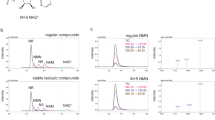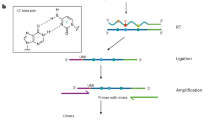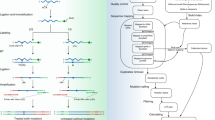Abstract
DNA contains not only canonical nucleotides but also a variety of modifications of the bases. In particular, cytosine and adenine are frequently modified. Determination of the exact quantity of these noncanonical bases can contribute to the characterization of the state of a biological system, e.g., determination of disease or developmental processes, and is therefore extremely important. Here, we present a workflow that includes detailed description of critical sample preparation steps and important aspects of mass spectrometry analysis and validation. In this protocol, extraction and digestion of DNA by an optimized spin-column and enzyme–based method are described. Isotopically labeled standards are added in the course of DNA digestion, which allows exact quantification by isotope dilution mass spectrometry. To overcome the major bottleneck of such analyses, we developed a short (~14-min-per-sample) ultra-HPLC (UHPLC) and triple quadrupole mass spectrometric (QQQ-MS) method. Easy calculation of the modification abundance in the genome is possible with the provided evaluation sheets. Compared to alternative methods, the quantification procedure presented here allows rapid, ultrasensitive (low femtomole range) and highly reproducible quantification of different nucleosides in parallel. Including sample preparation and evaluation, quantification of DNA modifications can be achieved in less than a week.
This is a preview of subscription content, access via your institution
Access options
Access Nature and 54 other Nature Portfolio journals
Get Nature+, our best-value online-access subscription
$29.99 / 30 days
cancel any time
Subscribe to this journal
Receive 12 print issues and online access
$259.00 per year
only $21.58 per issue
Buy this article
- Purchase on Springer Link
- Instant access to full article PDF
Prices may be subject to local taxes which are calculated during checkout








Similar content being viewed by others
References
Kriaucionis, S. & Heintz, N. The nuclear DNA base 5-hydroxymethylcytosine is present in Purkinje neurons and the brain. Science 324, 929–930 (2009).
Tahiliani, M. et al. Conversion of 5-methylcytosine to 5-hydroxymethylcytosine in mammalian DNA by MLL partner TET1. Science 324, 930–935 (2009).
Pfaffeneder, T. et al. The discovery of 5-formylcytosine in embryonic stem cell DNA. Angew. Chem. Int. Ed. Engl. 50, 7008–7012 (2011).
Ito, S. et al. Tet proteins can convert 5-methylcytosine to 5-formylcytosine and 5-carboxylcytosine. Science 333, 1300–1303 (2011).
He, Y.-F. et al. Tet-mediated formation of 5-carboxylcytosine and its excision by TDG in mammalian DNA. Science 333, 1303-1307 (2011).
Wu, H. & Zhang, Y. Mechanisms and functions of Tet protein-mediated 5-methylcytosine oxidation. Gene. Dev. 25, 2436–2452 (2011).
Branco, M. R., Ficz, G. & Reik, W. Uncovering the role of 5-hydroxymethylcytosine in the epigenome. Nat. Rev. Genet. 13, 7–13 (2011).
Langemeijer, S. M. C. et al. Acquired mutations in TET2 are common in myelodysplastic syndromes. Nat. Genet. 41, 838–842 (2009).
Ko, M. et al. Impaired hydroxylation of 5-methylcytosine in myeloid cancers with mutant TET2. Nature 468, 839–843 (2010).
Jones, P. A. & Baylin, S. B. The epigenomics of cancer. Cell 128, 683-692 (2007).
Pfaffeneder, T. et al. Tet oxidizes thymine to 5-hydroxymethyluracil in mouse embryonic stem cell DNA. Nat. Chem. Biol. 10, 574–581 (2014).
Bachman, M. et al. 5-Formylcytosine can be a stable DNA modification in mammals. Nat. Chem. Biol. 11, 555–557 (2015).
Iwan, K. et al. 5-Formylcytosine to cytosine conversion by C–C bond cleavage in vivo. Nat. Chem. Biol. 14, 72–78 (2018).
Raiber, E.-A. et al. 5-Formylcytosine alters the structure of the DNA double helix. Nat. Struct. Mol. Biol. 22, 44–49 (2014).
Song, C. X. et al. Genome-wide profiling of 5-formylcytosine reveals its roles in epigenetic priming. Cell 153, 678–691 (2013).
Kellinger, M. W. et al. 5-formylcytosine and 5-carboxylcytosine reduce the rate and substrate specificity of RNA polymerase II transcription. Nat. Struct. Mol. Biol. 19, 831–833 (2012).
Zhu, C. et al. Single-cell 5-formylcytosine landscapes of mammalian early embryos and ESCs at single-base resolution. Cell Stem Cell 20, 720–731.e5 (2017).
Hill, P. W. S., Amouroux, R. & Hajkova, P. DNA demethylation, Tet proteins and 5-hydroxymethylcytosine in epigenetic reprogramming: an emerging complex story. Genomics 104, 324–333 (2014).
Yu, M. et al. Base-resolution detection of N(4)-methylcytosine in genomic DNA using 4mC-Tet-assisted-bisulfite sequencing. Nucleic Acids Res. 43, e148 (2015).
Ehrlich, M. et al. DNA methylation in thermophilic bacteria: N4-methylcytosine, 5-methylcytosine, and N6-methyladenine. Nucleic Acids Res. 13, 1399–1412 (1985).
Arber, W. & Dussoix, D. Host specificity of DNA produced by Escherichia coli: I. Host controlled modification of bacteriophage λ. J. Mol. Biol. 5, 18–36 (1962).
Wu, T. P. et al. DNA methylation on N6-adenine in mammalian embryonic stem cells. Nature 532, 329–333 (2016).
Huang, W. et al. Determination of DNA adenine methylation in genomes of mammals and plants by liquid chromatography/mass spectrometry. RSC Adv. 5, 64046–64054 (2015).
Koziol, M. J. et al. Identification of methylated deoxyadenosines in vertebrates reveals diversity in DNA modifications. Nat. Struct. Mol. Biol. 23, 24–30 (2015).
Liu, J. et al. Abundant DNA 6mA methylation during early embryogenesis of zebrafish and pig. Nat. Commun. 7, 13052 (2016).
Schiffers, S. et al. Quantitative LC–MS provides no evidence for m6dA or m4dC in the genome of mouse embryonic stem cells and tissues. Angew. Chem. Int. Ed. Engl. 56, 11268–11271 (2017).
Wang, D., Kreutzer, D. A. & Essigmann, J. M. Mutagenicity and repair of oxidative DNA damage: insights from studies using defined lesions. Mutat. Res. 400, 99–115 (1998).
Cooke, M. S., Evans, M. D., Dizdaroglu, M. & Lunec, J. Oxidative DNA damage: mechanisms, mutation, and disease. FASEB J. 17, 1195–1214 (2003).
Lunec, J. ESCODD: European standards committee on oxidative DNA damage. Free Radical Res. 29, 601–608 (1998).
Murray, K. K. et al. Definitions of terms relating to mass spectrometry (IUPAC Recommendations 2013). Pure Appl. Chem. 85, 1515–1609 (2013).
Oakeley, E. J. DNA methylation analysis: a review of current methodologies. Pharmacol. Ther. 84, 389–400 (1999).
Taghizadeh, K. et al. Quantification of DNA damage products resulting from deamination, oxidation and reaction with products of lipid peroxidation by liquid chromatography isotope dilution tandem mass spectrometry. Nat. Protoc. 3, 1287–1298 (2008).
Annesley, T. M. Ion suppression in mass spectrometry. Clin. Chem. 49, 1041–1044 (2003).
Buhrman, D. L., Price, P. I. & Rudewiczcor, P. J . Quantitation of SR 27417 in human plasma using electrospray liquid chromatography–tandem mass spectrometry: a study of ion suppression.J. Am. Soc. Mass Spectrom 7, 1099–1105 (1996).
Brückl, T., Globisch, D., Wagner, M., Müller, M. & Carell, T. Parallel isotope-based quantification of modified tRNA nucleosides. Angew. Chem. Int. Ed. Engl. 48, 7932–7934 (2009).
Münzel, M. et al. Quantification of the sixth DNA base hydroxymethylcytosine in the brain. Angew. Chem. Int. Ed. Engl. 49, 5375–5377 (2010).
Globisch, D. et al. Tissue distribution of 5-hydroxymethylcytosine and search for active demethylation intermediates. PLoS ONE 5, e15367 (2010).
Pearson, D. et al. LC-MS based quantification of 2′-ribosylated nucleosides Ar(p) and Gr(p) in tRNA. Chem. Commun. 47, 5196–5198 (2011).
Globisch, D. et al. Systems-based analysis of modified tRNA bases. Angew. Chem. Int. Ed. Engl. 50, 9739–9742 (2011).
Wetzel, C. & Limbach, P. A. Global identification of transfer RNAs by liquid chromatography–mass spectrometry (LC–MS). J. Proteomics 75, 3450–3464 (2012).
Schiesser, S. et al. Deamination, oxidation, and C–C bond cleavage reactivity of 5-hydroxymethylcytosine, 5-formylcytosine, and 5-carboxycytosine. J. Am. Chem. Soc. 135, 14593–14599 (2013).
Schröder, A. S. et al. Synthesis of a DNA promoter segment containing all four epigenetic nucleosides: 5-methyl-, 5-hydroxymethyl-, 5-formyl-, and 5-carboxy-2′-deoxycytidine. Angew. Chem. Int. Ed. Engl. 53, 315–318 (2014).
Thienpont, B. et al. Tumour hypoxia causes DNA hypermethylation by reducing TET activity. Nature 537, 63–68 (2016).
Rahimoff, R. et al. 5-Formyl- and 5-carboxydeoxycytidines do not cause accumulation of harmful repair intermediates in stem cells. J. Am. Chem. Soc. 139, 10359–10364 (2017).
Turowski, M. et al. Deuterium isotope effects on hydrophobic interactions: the importance of dispersion interactions in the hydrophobic phase. J. Am. Chem. Soc. 125, 13836–13849 (2003).
Kanao, E. et al. Isotope effects on hydrogen bonding and CH/CD−π interaction. J. Phys. Chem. 122, 15026–15032 (2018).
Liu, S. & Wang, Y. Mass spectrometry for the assessment of the occurrence and biological consequences of DNA adducts. Chem. Soc. Rev. 44, 7829–7854 (2015).
Lentini, A. et al. A reassessment of DNA-immunoprecipitation-based genomic profiling. Nat. Methods 15, 499–504 (2018).
Shrivastava, A. & Gupta, V. B. HPLC: isocratic or gradient elution and assessment of linearity in analytical methods. J. Adv. Sci. Res. 3, 12–20 (2012).
Schellinger, A. P. & Carr, P. W. Isocratic and gradient elution chromatography: a comparison in terms of speed, retention reproducibility and quantitation. J. Chromatogr. A 1109, 253–266 (2006).
Zhang, J. J. et al. Analysis of global DNA methylation by hydrophilic interaction ultra high-pressure liquid chromatography tandem mass spectrometry. Anal. Biochem. 413, 164–170 (2011).
Contreras-Sanz, A. et al. Simultaneous quantification of 12 different nucleotides and nucleosides released from renal epithelium and in human urine samples using ion-pair reversed-phase HPLC. Purinergic Signal. 8, 741–751 (2012).
Yonekura, S., Iwasaki, M., Kai, M. & Ohkura, Y. High-performance liquid chromatographic determination of guanine and its nucleosides and nucleotides in biospecimens with precolumn fluorescence derivatization using phenylglyoxal. Anal. Sci. 10, 247–251 (1994).
Giel-Pietraszuk, M. et al. Quantification of 5-methyl-2′-deoxycytidine in the DNA. Acta Biochim. Pol. 62, 281–286 (2015).
Pitt, J. J. Principles and applications of liquid chromatography-mass spectrometry in clinical biochemistry. Clin. Biochem. Rev. 30, 19–34 (2009).
Niessen, W. M. A. State-of-the-art in liquid chromatography–mass spectrometry. J. Chromatogr. A 856, 179–197 (1999).
Williamson, L. N. & Bartlett, M. G. Quantitative liquid chromatography/time-of-flight mass spectrometry. Biomed. Chromatogr. 21, 567–576 (2007).
Payne, A. H. & Glish, G. L. Tandem mass spectrometry in quadrupole ion trap and ion cyclotron resonance mass spectrometers. Methods Enzymol. 402, 109–148 (2005).
Tozuka, Z. et al. Strategy for structural elucidation of drugs and drug metabolites using (MS)n fragmentation in an electrospray ion trap. J. Mass Spectrom. 38, 793–808 (2003).
Ens, W. & Standing, K. G. Hybrid quadrupole/time-of-flight mass spectrometers for analysis of biomolecules. Methods Enzymol. 402, 49–78 (2005).
Commission Decision 2002/657/EC. Implementation of Council Directive 96/23/EC Concerning the Performance of Analytical Methods and the Interpretation of Results (Brussels, Official Journal of the European Communities, 2002).
Zhao, Z. & Zhang, F. Sequence context analysis in the mouse genome: single nucleotide polymorphisms and CpG island sequences. Genomics 87, 68–74 (2006).
Kellner, S. et al. Oxidation of phosphorothioate DNA modifications leads to lethal genomic instability. Nat. Chem. Biol. 13, 888–894 (2017).
Kellner, S. et al. Absolute and relative quantification of RNA modifications via biosynthetic isotopomers. Nucleic Acids Res. 42, e142 (2014).
Amouroux, R. et al. De novo DNA methylation drives 5hmC accumulation in mouse zygotes. Nat. Cell Biol. 18, 225–233 (2016).
Busskamp, V. et al. Rapid neurogenesis through transcriptional activation in human stem cells. Mol. Syst. Biol. 10, 760 (2014).
Li, E., Bestor, T. H. & Jaenisch, R. Targeted mutation of the DNA methyltransferase gene results in embryonic lethality. Cell 69, 915–926 (1992).
Collins, A. R., Cadet, J., Mőller, L., Poulsen, H. E. & Viña, J. Are we sure we know how to measure 8-oxo-7,8-dihydroguanine in DNA from human cells? Arch. Biochem. Biophys. 423, 57–65 (2004).
ESCODD. Comparative analysis of baseline 8-oxo-7,8-dihydroguanine in mammalian cell DNA, by different methods in different laboratories: an approach to consensus. Carcinogenesis 23, 2129–2133 (2002).
Ravanat, J.-L. et al. Cellular background level of 8-oxo-7,8-dihydro-2′-deoxyguanosine: an isotope based method to evaluate artefactual oxidation of DNA during its extraction and subsequent work-up. Carcinogenesis 23, 1911–1918 (2002).
Acknowledgements
We thank the Deutsche Forschungsgemeinschaft for funding through SFB749, SFB1032, SPP1784 and CA275-11/1. Further support is acknowledged from the Excellence Cluster CiPSM (Center for Integrated Protein Science). F.R.T. thanks the Boehringer Ingelheim Fonds for her PhD fellowship. S.K. thanks the Fonds der Chemischen Industrie for the Liebig Fellowship. We thank T. Pfaffeneder for early method development and helpful input. We thank S. Michalakis (Department of Pharmacy, Ludwig-Maximilians–Universität München) for providing mouse tissues.
Author information
Authors and Affiliations
Contributions
F.R.T., S.S. and K.I. designed and developed the protocol. S.K. provided expertise on mass spectrometry. F.S. developed the DNA isolation protocol. M.M. designed graphics. T.C. supervised and designed the studies. All authors participated in writing the manuscript.
Corresponding author
Ethics declarations
Competing interests
The authors declare no competing interests.
Additional information
Publisher’s note: Springer Nature remains neutral with regard to jurisdictional claims in published maps and institutional affiliations.
Related links
Key references using this protocol
Pfaffeneder, T. et al. Nat. Chem. Biol. 10, 574–581 (2014): https://www.nature.com/articles/nchembio.1532
Iwan, K. et al. Nat. Chem. Biol. 14, 72–78 (2018): https://www.nature.com/articles/nchembio.2531
Schiffers, S. et al. Angew. Chem. Int. Ed. Engl. 56, 11268–11271 (2017): https://onlinelibrary.wiley.com/doi/abs/10.1002/anie.201700424
Rahimoff, R. et al. J. Am. Chem. Soc. 139, 10359–10364 (2017): https://pubs.acs.org/doi/10.1021/jacs.7b04131
Rights and permissions
About this article
Cite this article
Traube, F.R., Schiffers, S., Iwan, K. et al. Isotope-dilution mass spectrometry for exact quantification of noncanonical DNA nucleosides. Nat Protoc 14, 283–312 (2019). https://doi.org/10.1038/s41596-018-0094-6
Published:
Issue Date:
DOI: https://doi.org/10.1038/s41596-018-0094-6
This article is cited by
-
Tracking chromatin state changes using nanoscale photo-proximity labelling
Nature (2023)
-
Genome-wide deposition of 6-methyladenine in human DNA reduces the viability of HEK293 cells and directly influences gene expression
Communications Biology (2023)
-
Comprehensive comparison between azacytidine and decitabine treatment in an acute myeloid leukemia cell line
Clinical Epigenetics (2022)
-
Flanking sequences influence the activity of TET1 and TET2 methylcytosine dioxygenases and affect genomic 5hmC patterns
Communications Biology (2022)
-
The central role of DNA damage in the ageing process
Nature (2021)
Comments
By submitting a comment you agree to abide by our Terms and Community Guidelines. If you find something abusive or that does not comply with our terms or guidelines please flag it as inappropriate.



